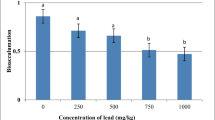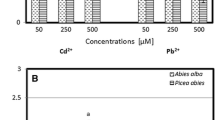Abstract
The objective of this study was to evaluate lead phytotoxicity on Talinum patens and the morpho-physiological tolerance mechanisms. The following parameters were considered: germination percentage, germination speed index, root and shoot length, fresh and dry matter, lead content in tissues, enzymatic antioxidant system, proline content, lipid peroxidation, root anatomy, cytogenetic analysis, and chlorophyll fluorescence. The experimental design was completely randomized, with five concentrations: 0, 50, 100, 250, and 500 μM Pb(NO3)2 and five replicates. Exposure to Pb(NO3)2 solutions did not influence germination, shoot length, or fresh and dry matter. However, a Pb(NO3)2-dependent concentration effect was observed, which reduced cell division in the root meristematic zone (mitotic index), reducing their length. Superoxide dismutase, catalase, and ascorbate peroxidase showed increased activity when exposed to lead, and the same effect was detected for proline content and lipid peroxidation. There was an increase in the dissipation of excess energy in photosystems, as well as an increase in epidermal thickness. Therefore, Talinum patens plants had morpho-physiological characteristics that favor their germination, development, and metal tolerance.







Similar content being viewed by others
References
Adam, F. I. M., & El-Ashry, Z. M. (2010). Evaluation of genotoxicity of 4-n-nonylphenol using Vicia faba L. Journal of Biological Sciences, 10, 368–372.
Ahmad, S. H., Reshi, Z., Ahmad, J., & Iqbal, M. (2005). Morpho-anatomical responses of Trigonella foenum graecum Linn. to induced cadmium and lead stress. Journal of Plant Biology, 48, 64–84.
Ahmad, M. S. A., Ashraf, M., Tabassam, Q., Hussain, M., & Firdous, H. (2011). Lead (Pb)-induced regulation of growth, photosynthesis, and mineral nutrition in maize (Zea mays L.) plants at early growth stages. Biological Trace Element Research, 144, 1229–1239.
Akinola, M. O., & Ekiyoyo, T. A. (2006). Accumulation of lead, cadmium and chromium in some plants cultivated along the bank of river Ribila at Odonla area of Ikorodu, Lagos state, Nigeria. Journal of Environmental Biology, 27, 597–599.
Arias, J. A., Peralta-Videa, J. R., Ellzey, J. T., Ren, M., Viveros, M. N., & Gardea-Torresdey, J. A. (2010). Effects of Glomus deserticola inoculation on Prosopis: enhancing chromium and lead uptake and translocation as confirmed by X-ray mapping, ICP-OES and TEM techniques. Environment and Experimental Botany, 68, 139–148.
Asada, K., & Takahashi, M. (1987). Production and scavenging of active oxygen in chloroplasts. In J. Kyle, C. B. Osmond, & K. Arntzen (Eds.), Photoinhibition (pp. 227–287). Amsterdam: Elsevier.
Barceló, J., & Poschenrieder, C. (1996). Aluminium phytotoxicity, a challenge for plant scientists. Fertilizer Research, 43, 217–223.
Bhattacharjee, S. (2010). Sites of generation and physicochemical basis of formation of reactive oxygen species in plant cell. In S. D. Gupta (Ed.), Reactive oxygen species and antioxidants in higher plants (pp. 1–30). Enfield: Science Publishers.
Biemelt, S., Keetman, U., & Albrecht, G. (1998). Re-aeration following hypoxia or anoxia leads to activation of the antioxidative defense system in roots of wheat seedllings. Plant Physiology, 116, 651–658.
Bradford, M. M. (1976). A rapid and sensitive method for the quantitation of microgram quantities of protein utilizing the principle of protein-dye binding. Analytical Biochemistry, 7, 248–254.
Buege, J. A., & Aust, S. D. (1978). Microsomal lipid peroxidation. Methods and Enzimology, 52, 302–310.
Carruyo, I., Fernández, Y., Marcano, L., Montiel, X., & Torrealba, Z. (2008). Correlation of toxicity with lead content in root tip cells (Allium cepa L.) Biological Trace Element Research, 125, 276–285.
Gautam, M., Singh, A. K., & Johri, R. M. (2011). Impact of lead contaminated water on root morphology of tomato and brinjal. Indian Journal of Horticulture, 68, 512–515.
George, E. F., & Sherrington, P. D. (1984). Plant propagation by tissue culture: handbook and directory of commercial laboratories. Eversley: Exegetics.
Giannopolitis, C. N., & Ries, S. K. (1997). Superoxide dismutase: I., occurrence in higher plants. Plant Physiology, 59, 309–314.
Gill, S. S., & Tuteja, N. (2010). Reactive oxygen species and antioxidant machinery in abiotic stress tolerance in crop plants. Plant Physiology and Biochemistry, 48, 909–930.
Gomes, M. B., Banys, V. L., Santos, J., Castro, A. L. A., Saenz, E. A. C., & Fialho, C. A. (2012). Morphogenesis in the germination and establishment phase of Brachiaria ruziziensis subjected to fertilization with nitrogen and potassium. Ciência Rural, 42, 2235–2241.
Gupta, D. K., Huang, H. G., & Corpas, F. J. (2013). Lead tolerance in plants: strategies for phytoremediation. Environmental Science and Pollution Research, 20, 2150–2161.
Havir, E. A., & Mchale, N. A. (1987). Biochemical and development characterization of multiple forms of catalase in tabacco leaves. Plant Physiology, 84, 450–455.
Jiang, Z., Zhang, H., Qin, R., Zou, J., Wang, J., Shi, Q., Jiang, W., & Liu, D. (2014). Effects of lead on the morphology and structure of the nucleolus in the root tip meristematic cells of Allium cepa L. International Journal of Molecular Sciences, 15, 13406–13423.
Kosobrukhov, A., Knyazeva, I., & Mudrik, V. (2004). Plantago major plants responses to increase content of lead in soil: growth and photosynthesis. Plant Growth Regulation, 42, 145–151.
Kumar, A., & Prasad, M. N. V. (2015). Lead-induced toxicity and interference in chlorophyll fluorescence in Talinum triangulare grown hydroponically. Photosynthetica, 53, 66–71.
Kumar, A., Prasad, M. N. V., & Sytar, O. (2012). Lead toxicity, defense strategies and associated indicative biomarkers in Talinum triangulare grown hydroponically. Chemosphere, 89, 1056–1065.
Lamhamdi, M., Bakrim, A., Aarab, A., Lafond, R., & Sayah, F. (2011). Lead phytotoxicity on wheat (Triticum aestivum L.) seed germination and seedlings growth. Comptes Rendus Biologies, 334, 118–126.
Lu, H., Li, Z., Fu, S., Mendez, A., Gasco, G., & Paz-Ferreiro, J. (2015). Combining phytoextraction and biochar addition improves soil biochemical properties in a soil contaminated with Cd. Chemosphere, 119, 209–216.
Mehta, S. K., & Gaur, J. P. (1999). Heavy-metal induced proline accumulation and its role in ameliorating metal toxicity in Chlorella vulgaris. The New Phytologist, 143, 253–259.
Moraes, R. M., Barbosa, S., Filho, P. R. S., Carvalho, M., & Nogueira, L. M. (2015). Effects of copper on physiological and cytological aspects in Lactuca sativa L. Brazilian Journal of Biosciences, 13, 115–121.
Mosango, M. (2004). Talinum paniculatum (Jacq.) Gaertn. Record from PROTA4U. Grubben, G.J.H. & Denton, O.A. (Editors). PROTA (Plant Resources of Tropical Africa/Ressources végétales de l’Afrique tropicale), Wageningen, Netherlands. http://www.prota4u.org/search.asp. Acessed 4 january 2017.
Mylona, P. V., & Polidoros, A. N. (2010). ROS regulation of antioxidant genes. In S. D. Gupta (Ed.), Reactive oxygen species and antioxidants in higher plants (pp. 101–128). Enfield: Science Publishers.
Nakano, Y., & Asada, K. (1981). Hydrogen peroxide is scavenged by ascorbato-especific peroxidase in spinach chloroplasts. Plant and Cell Physiology, 22, 867–880.
Oliveira, C. (2010). Morphoanatomical and physiological characteristics in the evaluation of the bioindicator and phytoremediator potential of Pistia stratiotes L. in the presence of cadmium, lead and arsenic. http://www.repositorio.ufla.br/handle/1/1498. Acessed 04/04/2017.
Oxborough, K. (2004). Imaging of chlorophyll a: theoretical and practical aspects of an emerging technique for the monitoring of photosynthetic performance. Journal of Experimental Botany, 55, 1195–1205.
Pedroso-de-Moraes, C., Souza-Leal, T., Panosso, A. R., & Souza, M. C. (2012). Effect of chemical scarification and concentration of nitrogen on the germination and in vitro development of Vanilla planifolia Jack ex Andr. (Orchidaceae: Vanilloideae). Acta Botanica Brasillica, 26, 714–719.
Pena, L. B., Méndez, A. A. E., Matayoshi, C. L., Zawoznick, M. S., & Gallego, S. M. (2015). Early response of wheat seminal roots growing under copper excess. Plant Physiology and Biochemistry, 87, 115–123.
Pereira, M. P., Pereira, F. J., Rodrigues, L. C. A., Barbosa, S., & Castro, E. M. (2013). Lead phytotoxicity on germination and early growth of lettuce as a function of root anatomy and cell cycle. Revista Agro@mbiente On- line, 7, 36–43.
Pourrut, B., Shahid, M., Dumat, C., Winterton, P., & Pinelli, E. (2011). Lead uptake, toxicity, and detoxification in plants. Reviews of Environmental Contamination and Toxicology, 213, 113–136.
Rajkumar, K., Sivakumar, S., Senthilkumar, P., Prabha, D., Subbhuraam, C. V., & Song, Y. C. (2009). Effects of selected heavy metals (Pb, Cu, Ni, and Cd) in the aquatic medium on the restoration potential and accumulation in the stem cuttings of the terrestrial plant, Talinum triangulare. Ecotoxicology, 18, 952–960.
Ribeiro, E. S., Pereira, M. P., Castro, E. M., Baroni, G. R. B., Corrêa, F. F., & Pereira, F. J. (2015). Relationship between root anatomy on the uptake, storage and tolerance to lead of Echinodorus grandiflorus. Revista Brasileira de Engenharia Agrícola e Ambiental, 19, 605–612.
Rodriguez, E., Santos, M. C., Azevedo, R., Correia, C., Moutinho-Pereira, J., Oliveira, J. M. P. F., & Dias, M. C. (2015). Photosynthesis light-independent reactions are sensitive biomarkers to monitor lead phytotoxicity in a Pb-tolerant Pisum sativum cultivar. Environmental Science and Pollution Research, 22, 574–585.
Rossato, L. V., Nicoloso, F. T., Farias, J. G., Cargnelluti, D., Tabaldi, L. A., Antes, F. G., Dressler, V. L., Morsch, V. M., & Schetinger, M. R. (2012). Effects of lead on the growth, lead accumulation and physiological responses of Pluchea sagittalis. Ecotoxicology, 21, 111–123.
Sharma, P., & Dubey, R. S. (2005). Lead toxicity in plants. Brazilian Journal of Plant Physiology, 17, 35–52.
Sharma, P., Jha, A. B., Dubey, R. S., & Pessarakli, M. (2012). Reactive oxygen species, oxidative damage, and antioxidative defense mechanism in plants under stressful conditions. Journal of Botany, 2012, 1–26.
Sigel, A., Sigel, H., & Sigel, R. K. O. (2013). Metal ions in life sciences. Cadmium: from toxicity to essentiality (p. 11). Dordrecht: Springer.
Souza, T. C., Castro, E. M., Pereira, F. J., Parentoni, S. N., & Magalhães, P. C. (2009). Morphoanatomical characterizationof root in recurrent selection cycles for flood tolerance of maize (Zea mays L.) Plant Soil and Environment, 55, 504–510.
Sytar, O., Kumar, A., Latowski, D., Kuczynska, P., Strzałka, K., & Prasad, M. N. V. (2013). Heavy metals induced oxidative damage, defence reactions and detoxification mechanisms in plants. Acta Physiologiae Plantarum, 35, 985–999.
Thangavel, P., & Subburam, V. (1998). Effect of trace metals in restoration potencial of leaves medicinal plant Portulaca oleracea. Biology Trace Elements Research, 61, 313–321.
Torello, W. A., & Rice, L. A. (1986). Effects of NaCl stress on proline and cation accumulation in salt sensitive and tolerant turfgrasses. Plant and Soil, 93, 241–247.
Tripathi, B. N., & Gaur, J. P. (2004). Relationship between copper and zinc induced oxidative stress and proline accumulation in Scenedesmus sp. Planta, 219, 397–404.
Wang, Y., Li, Y., Ma, C., & Qiu, D. (2016). Gas exchange, photosystem II photochemistry, and the antioxidant system of longan plant (Dimocarpus longan Lour.) leaves in response to lead (Pb) stress. Plant Omics Journal, 9, 240–247.
Wierzbicka, M., & Obidzińska, J. (1998). The effect of lead onseed imbibition and germination in different plant species. Plant Science, 137, 155–171.
Xu, J., Duan, X., Yang, J., Beeching, J. R., & Zhang, P. (2013). Enhanced reactive oxygen species scavenging by overproduction of superoxide dismutase and catalase delays postharvest physiological deterioration of cassava storage roots. Plant Physiology, 161, 1517–1528.
Funding
The authors would like to thank Coordenação de Aperfeiçoamento de Pessoal de Nível Superior (CAPES) for the master’s scholarship and the financial aid for the purchase of the device FluorCam (PRÓ-EQUIPAMENTOS, public notice no. 11/2014); Fundação de Amparo à Pesquisa do Estado de Minas Gerais (FAPEMIG) and Conselho Nacional de Desenvolvimento Científico e Tecnológico (CNPq) for the scientific initiation PIBICT/FAPEMIG (Veroneze Júnior, V.) and PIBIC/CNPq (Silva, J.A.) scholarships, respectively.
Author information
Authors and Affiliations
Corresponding author
Rights and permissions
About this article
Cite this article
Gonzales de Souza, G., Mendes Pinheiro, A.L., Silva, J.A. et al. Morpho-physiological Tolerance Mechanisms of Talinum patens to Lead. Water Air Soil Pollut 229, 4 (2018). https://doi.org/10.1007/s11270-017-3658-0
Received:
Accepted:
Published:
DOI: https://doi.org/10.1007/s11270-017-3658-0




